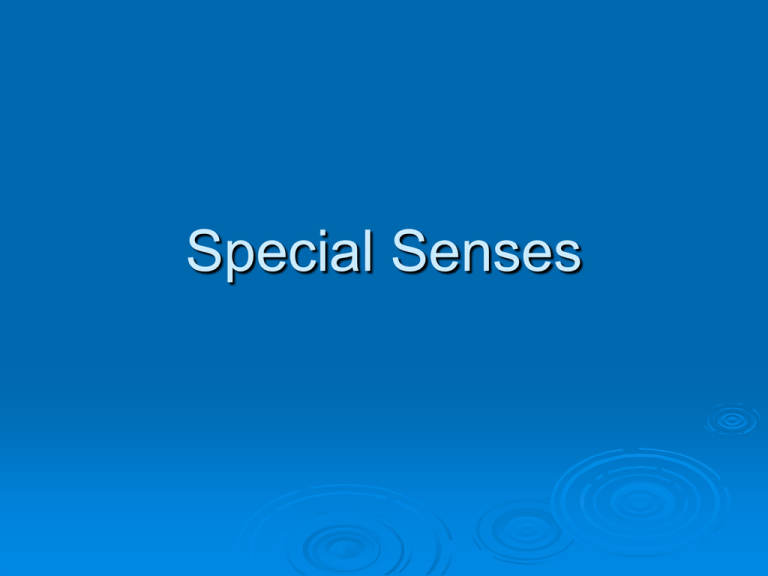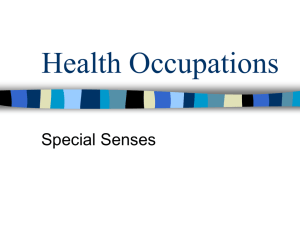Special Senses
advertisement

Special Senses Special Senses Special senses allow the human body to react to the environment. Helps the body to see, hear, taste, smell, and maintain balance. Senses occur because the body has structures that receive the sensation, nerves that carry the sensory message to the brain, and a brain that can interpret and respond to the message. The Eye Organ that controls the special sense of sight. It does this by receiving light rays and transmitting the light rays to the optic nerve, which carries the rays to the brain where they are interpreted as vision or sight. The Eye The eye is protected by the bony socket of the skull, eye lashes and lids, and lacrimal glands which produce tears. The conjunctiva is mucous membrane that protects the eye. It lines the eyelids and covers the front of the eye. Three Main Layers of the Eye Sclera The “whites” of the eye is the outermost layer made up of connective tissue. Muscles which are responsible for movement of the eye within the socket are attached to the outside of the sclera. On the front of the sclera there is a transparent part called the cornea which allows light rays to enter the eye. Three Main Layers of the Eye Choroid Coat The middle layer of the eye, which has many blood vessels that nourish the eye. The pupil is a hole in front of the choroids coat which allows light to enter. The iris is the colored portion of the eye and is a muscle which controls the pupil and regulates the amount of light entering the eye. Three Main Layers of the Eye The retina is the innermost layer of the eye. It is made up of layers of nerve cells which transmit the light impulses to the optic nerve. There are two special types of cells in the retina. 1. 2. Cones – Used mainly for light vision, and sensitive to color. They are located in the area of sharpest vision on the back surface of the retina. Rods – are used for dark or dim vision. The Eye Other special structures of the eye include the lens located behind the pupil. Its purpose is to refract or bend light rays so it can focus on the retina. The aqueous humor is a clear watery fluid that helps maintain the curvature of the eyeball and bends or refracts light rays. The vitreous humor is a jelly-like substance that fills the area behind the lens, and also helps to bend light rays. The Eye When light rays enter the eye they pass through a series of parts that bend or refract the rays to allow the rays to focus on the retina. In the retina, the rays or images are picked up by the rods and cones, changed into nerve impulses, and transmitted by the optic nerve to the occipital lobe of the brain where sight is interpreted. Diseases of the Eye Amblyopia Astigmatism Blurred vision caused by abnormal shape or curvature of the cornea. Cataracts Also called “lazy eye” Poor vision in one eye Lenses become cloudy or opaque, with resulting loss of vision. Conjunctivitis Also called “pink eye” Inflammation of the conjunctiva, usually caused by bacteria or a virus Diseases of the Eye Glaucoma Hyperopia Increased pressure in eye from excess amounts Leading cause of blindness Farsightedness Light rays are not refracted properly and the image is focused behind the retina Myopia Nearsightedness Light rays are focused in front of the retina Diseases of the Eye continued Presbyopia Farsightedness caused by loss of elasticity in the lens Strabismus Eyes do not move or focus together May move inward (Cross eyed), or outward, or up and down The Ear The ear is an organ that controls the special sense of hearing and balance. The ear transmits impulses from sound waves to the auditory nerve which carries the nerve impulses to the brain for interpretation as hearing. Three Main Sections of the Ear Outer ear Contain the pinna or auricle, which is the visible part of the year made up of elastic cartilage covered by skin. This leads to a canal called the auditory canal. The auditory canal contains glands which produce wax called cerumen, to protect the ear. Sound waves travel through the auditory canal, until they reach the eardrum or tympanic membrane. • The tympanic membrane vibrates when sound waves hit it and transmits the sound waves to the middle ear. Three Main Sections of the Ear Middle ear Contains three small bones • The malleus, incus and stapes. These are connected and transmit sound to the inner ear. Inner ear Most complex portion of the ear. There is a membrane which separates the inner and middle ear called the oval window. The vesibule is the first section or door to the inner ear. The next section is shaped like a snail’s shell and is called the cochlea. • The cochlea contains hair like cells which are the receptors for sound waves and transmit the impulses to the auditory nerve which transmits the impulses to the temporal lobe of the cerebrum to be interpreted as sound. The Inner Ear continued Also located in the inner ear is the semicircular canals which contain a liquid and hair-like cells that bend when the liquid moves with head and body movement. Impulses from this semicircular canal are sent to the cerebellum to maintain our sense of balance and equilibrium. Diseases of the Ear Hearing loss Meniere’s disease Collection of fluid in the inner ear Otitis externa Classified as sensory or conductive Inflammation of the external auditory canal. May be from swimmers’ ear, inserting bobby pins, Q-tips, fingernails, ect. Otitis media Inflammation of the middle ear. Frequently follows a sore throat due to bacteria entering the middle ear from that Eustachian tube. Other senses Sense of taste Dependent upon taste receptors on tongue Can detect sweet, sour, salty, and bitter Sense of smell The nose is the organ of smell. Impulses from the olfactory receptors in the upper part of the nasal cavity carry impulses to the brain by the olfactory nerve. Sense of smell is closely related to sense of taste. Smell is more sensitive than taste. The human nose can detect over 6,000 different smells Skin and General Sense General sense receptors for pressure, heat, cold, touch, and pain are located throughout the body in the skin and connective tissue. Messages through these receptors allow the human body to respond to its environment and protect it against injury.











